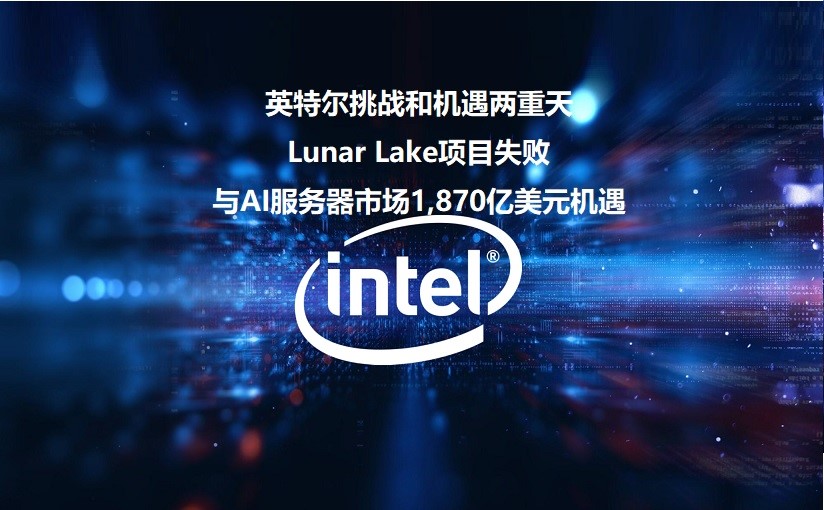In the fierce competition in the semiconductor industry, the failure of Intel's Lunar Lake (LNL) project stands in stark contrast to the rapid growth of the global AI server market. China Exportsemi will try to deeply analyze the reasons for the failure of the LNL project, the opportunities in the AI server market, and its impact on Intel and the industry, aiming to let the semiconductor industry practitioners gain some inspiration from it.
1. The underlying reasons for the failure of the LNL project
Project Intention and Technical Motivation:
The LNL project aims to compete with Apple Silicon and meet the challenge of Microsoft's Surface family of fully adopting Qualcomm processors. Intel has made a series of technical layouts for this purpose, including DRAM integration, specific component supplier designation, and plans to increase NPU computing power to 48 TOPS. However, in the end, the project failed to achieve its goal, and the reasons behind it are quite complex.
Technical & Market Barriers:
Intel attributed part of the failure of LNL to the cost pressures of DRAM integration. However, market observer Ming-Chi Kuo points out that the real problem lies in the lack of flexibility in the supply chain. In contrast, Apple has more bargaining power over suppliers, while Intel is relatively at a disadvantage when it comes to DRAM procurement. In addition, LNL needs to rely on TSMC foundry, which also increases costs. However, the application of AI PC is not yet mature, so users are reluctant to pay for high-cost LNL equipment. Together, these factors have led to LNL's poor market competitiveness.
Organizational & Planning Challenges:
The failure of the LNL project further exposed Intel's shortcomings in product planning. Unlike Intel, AMD's share of the conventional server market continues to rise, indicating that its product planning and market response are more flexible. Intel's internal organizational mechanism may be the root cause of decision-making errors, and its ability to control the overall design of the project and market demand needs to be improved urgently.

Figure: Intel's Challenges and Opportunities, with the failure of the Lunar Lake project and the $187 billion opportunity in the AI server market
2. Growth potential of the AI server market
Market size and development trend:
Despite the setback of the LNL project, the global AI server market is showing strong growth. According to statistics, the global AI server market will reach $21.1 billion in 2023 and is expected to increase to $31.79 billion by 2025, with an average annual growth rate of 22.7% from 2023 to 2025. At the same time, China's accelerated server market is expected to reach $25.3 billion by 2028, with the market share of non-GPU servers approaching 50%, indicating the increasing demand for diversified AI hardware solutions.
Computing power requirements driven by large models:
The development of large AI models has driven a surge in the demand for computing power, especially in industries such as finance, manufacturing, and energy, where AI servers have become an indispensable infrastructure. With the expansion of the application of large models, the AI server market is also expanding rapidly. The growing demand for large-scale data processing and real-time analytics will continue to drive the rapid development of the AI server market and bring opportunities to related enterprises.
Acceleration of the construction of intelligent computing center:
The rapid adoption of intelligent computing centers has further boosted the demand for AI servers. The construction of the intelligent computing center not only creates new demand for technology companies, but also pushes AI servers to more vertical industries. In the next few years, the extensive construction of intelligent computing centers around the world will significantly increase the market potential of AI servers and further expand the business opportunities of companies such as Intel.
3. Future outlook and industry implications
The failure of Intel's Lunar Lake program has demonstrated the challenges faced by semiconductor companies in a rapidly changing market environment in many ways. This event shows that in addition to process technology, product planning and supply chain management capabilities are just as important in today's competitive market. Intel needed to revisit its internal organizational structure and decision-making processes to ensure that future projects could better adapt to market demands.
However, the rapid growth of the AI server market has opened up new opportunities for Intel. With the global AI server market expected to reach $187 billion by 2028, Intel still has a lot to offer in hardware innovation in AI. Intel needs to accelerate technology development, improve its competitiveness in the AI server market, and accelerate product implementation and market layout to occupy a favorable position in this new round of competition.
4. Conclusion
The failure of the LNL project is a lesson for Intel at the technical, market, and organizational levels, and serves as a reminder of the importance of product planning and supply chain management for the semiconductor industry. With the rapid rise of the AI server market, Intel must increase its investment in innovation and improve its responsiveness to market demand in order to maintain its position in the future competition. As the AI server market continues to expand, Intel has the opportunity to not only reposition itself strategically, but also capitalize on this booming market demand to transform and grow its business.






